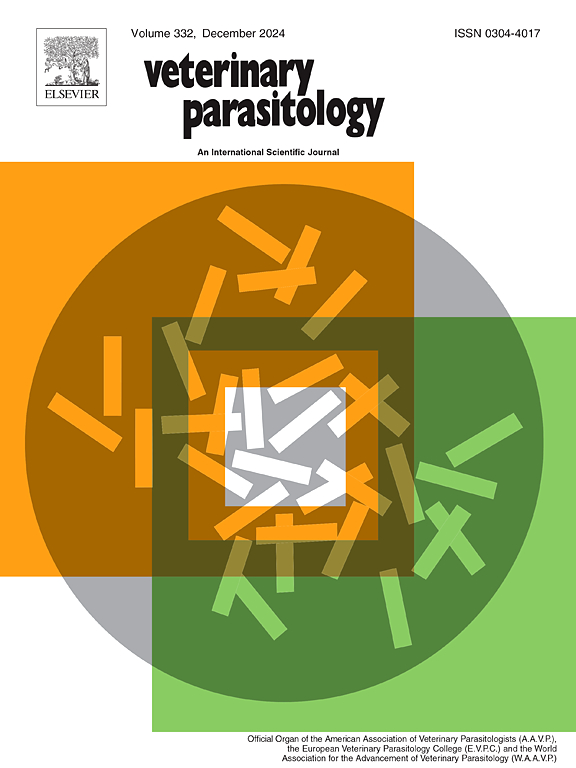精油对环纹棘头蜱(蜱螨目:伊蚊科)的杀幼、杀卵和驱避作用
IF 2
2区 农林科学
Q2 PARASITOLOGY
引用次数: 0
摘要
蜱是影响牲畜、传播疾病和造成经济损失的重要体外寄生虫。本研究在实验室控制条件下,评价了香合木、牛皮草和茴香草精油对环形鼻头虫(Boophilus)的杀幼虫、杀卵和驱避活性。选择这些植物是因为它们有充分的生物活性化合物,以其抗菌、杀虫和杀螨特性而闻名。以不同浓度(1、2.5、5、10和20% %)的精油进行试验,以评估其与合成杀螨剂氯菊酯的效果。香薰油的杀虫效果最高,死亡率为85.7 %,致死率为20% %,显著优于合成杀螨剂,LC50值为2.59 %。其杀卵活性也显著降低了卵的孵化率,最高浓度时对卵的孵化率为79.9% %,LC50值为5.07 %。氯菊酯的杀卵LC50值较低,但其总杀螨活性不超过精油。与香芹相比,香芹和香芹虽然有效,但表现出中等的杀幼虫、杀卵和驱避效果。这些发现突出了精油,特别是香薰精油作为蜱虫控制的天然替代品的潜力,减少了对合成杀螨剂的依赖,并促进了可持续的害虫管理策略。本文章由计算机程序翻译,如有差异,请以英文原文为准。
Larvicidal, ovicidal, and repellent activity of selected essential oils on the Rhipicephalus (Boophilus) annulatus (Acari: Ixodidae)
Ticks are significant ectoparasites affecting livestock, transmitting diseases, and causing economic losses. This study evaluates the larvicidal, ovicidal, and repellent activities of Syzygium aromaticum, Lippia adoensis, and Clausena anisate essential oils against Rhipicephalus (Boophilus) annulatus under controlled laboratory conditions. These plants were selected due to their well-documented bioactive compounds, known for their antimicrobial, insecticidal, and acaricidal properties. Essential oils were tested at various concentrations (1, 2.5, 5, 10 and 20 %) to assess their effectiveness compared to synthetic acaricide, permethrin. S. aromaticum oil demonstrated the highest larvicidal efficacy, achieving 85.7 % mortality at 20 %, significantly outperforming synthetic acaricide, with an LC50 value of 2.59 %. Its ovicidal activity also resulted in a notable reduction in egg hatchability, inhibiting 79.9 % of eggs at its highest concentration, reaching to LC50 value of 5.07 %. Despite its low ovicidal LC50 value, permethrin did not surpass the total acaricidal activity of essential oils. C. anisata and L. adoensis, while effective, demonstrated moderate larvicidal, ovicidal, and repellent effects compared to S. aromaticum. These findings highlight the potential of essential oils, specifically S. aromaticum as natural alternatives for tick control, reducing reliance on synthetic acaricides and promoting sustainable pest management strategies.
求助全文
通过发布文献求助,成功后即可免费获取论文全文。
去求助
来源期刊

Veterinary parasitology
农林科学-寄生虫学
CiteScore
5.30
自引率
7.70%
发文量
126
审稿时长
36 days
期刊介绍:
The journal Veterinary Parasitology has an open access mirror journal,Veterinary Parasitology: X, sharing the same aims and scope, editorial team, submission system and rigorous peer review.
This journal is concerned with those aspects of helminthology, protozoology and entomology which are of interest to animal health investigators, veterinary practitioners and others with a special interest in parasitology. Papers of the highest quality dealing with all aspects of disease prevention, pathology, treatment, epidemiology, and control of parasites in all domesticated animals, fall within the scope of the journal. Papers of geographically limited (local) interest which are not of interest to an international audience will not be accepted. Authors who submit papers based on local data will need to indicate why their paper is relevant to a broader readership.
Parasitological studies on laboratory animals fall within the scope of the journal only if they provide a reasonably close model of a disease of domestic animals. Additionally the journal will consider papers relating to wildlife species where they may act as disease reservoirs to domestic animals, or as a zoonotic reservoir. Case studies considered to be unique or of specific interest to the journal, will also be considered on occasions at the Editors'' discretion. Papers dealing exclusively with the taxonomy of parasites do not fall within the scope of the journal.
 求助内容:
求助内容: 应助结果提醒方式:
应助结果提醒方式:


